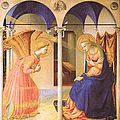Fra Angelico and the Rise of the Florentine Renaissance
Museo Nacional del Prado, Madrid
May 28, 2019 - September 15, 2019
|
Fra Angelico and the Rise of the Florentine RenaissanceMuseo Nacional del Prado, MadridMay 28, 2019 - September 15, 2019
Fra Angelico and the Rise of the Florentine Renaissance, an exhibition sponsored by the Fundación Amigos del Museo del Prado, analyses the artistic importance of the early Florentine Renaissance between approximately 1420 to 1430, with a particular focus on the figure of Fra Angelico, one of the great masters of this period. The exhibition, which includes 82 works loaned by more than 40 institutions in Europe and America, centres on The Annunciation in the collection of the Museo del Prado, which is now presented in all its splendour following its recent restoration. Shown alongside it are The Virgin of the Pomegranate, which recently entered the Museum’s collection, and an extensive group of works by the artist and by other painters of this period such as Masaccio, Masolino and Filippo Lippi, as well as sculptors including Donatello and Ghiberti. Curated by Carl Brandon Strehlke, Curator Emeritus at the Philadelphia Museum of Art and a renowned expert on Fra Angelico and other Florentine Renaissance painters, the exhibition is on display in Rooms C and D of the Jerónimos Building until 15 September. Fra Angelico trained as a painter in Florence where the public commissions for sculpture and architecture undertaken by Brunelleschi, Donatello and Ghiberti led to a renewed interest in classical antiquity as a source of inspiration. Although he was an apprentice in the studio of the Benedictine monk Lorenzo Monaco, who cultivated a refined and elegant Gothic style, Fra Angelico fully committed himself to the new artistic language and, like his master, entered a religious house, San Domenico in Fiesole, where he took religious orders. His status as a monk did not prevent him from collaborating with other artists or from running a large workshop that provided paintings for both churches and important patrons in the city and elsewhere. Among the altarpieces painted by the artist for his own monastery was The Annunciation now in the Museo del Prado and the centrepiece of the present exhibition. In that work Fra Angelico reveals his active participation in the renaissance of the arts that was taking place in Florence, given that alongside the younger Masaccio he formulated a new way of seeing which would come to dominate Western art until the modern age. Dating from the mid-1420s, The Annunciation is the first Florentine altarpiece in the Renaissance style to use perspective to organise the space and in which Gothic arcading is abandoned in favour of a more orthogonal structure, following the precepts favoured by Brunelleschi. Due to his status as a monk, Fra Angelico’s abilities in the depiction of light, space, perspective and narrative have often been eclipsed by his merits as a theological painter. The Annunciation arrived in Spain in 1611 and was probably the first work by the artist to leave Italy, while The Virgin of the Pomegranate was acquired in 1817 by the 1st Duke of Alba at a time when the importance of the early Florentine Renaissance was being rediscovered. Two accounts thus overlap in the exhibition: Florence as seen by Fra Angelico and Fra Angelico viewed through Spanish eyes.
|


